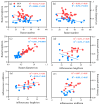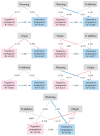Plant Origin Regulates the Response of Solidago canadensis Reproductive Traits to Long-Term Warming and Nitrogen Addition
- PMID: 40508384
- PMCID: PMC12157763
- DOI: 10.3390/plants14111711
Plant Origin Regulates the Response of Solidago canadensis Reproductive Traits to Long-Term Warming and Nitrogen Addition
Abstract
Climate warming and nitrogen (N) deposition have already occurred and will continue to occur, profoundly affecting exotic plant invasion. Most studies on the effects of climate change focus on plant growth, biomass, and leaf traits, with limited reports on reproductive responses. We selected Solidago canadensis from North America and China as focal species and conducted a long-term common garden experiment simulating climate warming and N deposition to examine how climate warming, N addition, and plant origin influence its reproductive traits. Chinese Solidago canadensis exhibited significantly greater ramet height, more robust ramet diameters, longer and wider inflorescences, and higher seed mass compared to North American Solidago canadensis. Long-term warming and plant origin alone or in combination significantly influenced reproductive traits, while N addition did not influence these traits. The vegetative propagation of a native population was sensitive to warming and N addition, while the generative propagation of an invasive population was sensitive to their combined effects. These findings suggest that the reproductive strategies of Solidago canadensis varied with their origin, and plant origin might be important in mediating climate change effects on their reproduction under plant invasion.
Keywords: Solidago canadensis; climate warming; plant invasion; provenance; reproduction.
Conflict of interest statement
The authors declare no conflicts of interest.
Figures







Similar articles
-
Climate warming impacts chewing Spodoptera litura negatively but sucking Corythucha marmorata positively on native Solidago canadensis.Sci Total Environ. 2024 May 1;923:171504. doi: 10.1016/j.scitotenv.2024.171504. Epub 2024 Mar 7. Sci Total Environ. 2024. PMID: 38460690
-
Additive effects of warming and nitrogen addition on the performance and competitiveness of invasive Solidago canadensis L.Front Plant Sci. 2022 Nov 3;13:1017554. doi: 10.3389/fpls.2022.1017554. eCollection 2022. Front Plant Sci. 2022. PMID: 36407577 Free PMC article.
-
Warming, nitrogen deposition, and provenance shift above-belowground insect interactions and host compensatory growth.Ecology. 2024 Nov;105(11):e4445. doi: 10.1002/ecy.4445. Epub 2024 Oct 8. Ecology. 2024. PMID: 39376114
-
Selected Aspects of Invasive Solidago canadensis with an Emphasis on Its Allelopathic Abilities: A Review.Chem Biodivers. 2022 Oct;19(10):e202200728. doi: 10.1002/cbdv.202200728. Epub 2022 Sep 23. Chem Biodivers. 2022. PMID: 36056470 Review.
-
Allelopathy and Allelochemicals of Solidago canadensis L. and S. altissima L. for Their Naturalization.Plants (Basel). 2022 Nov 25;11(23):3235. doi: 10.3390/plants11233235. Plants (Basel). 2022. PMID: 36501274 Free PMC article. Review.
References
-
- Hou Q.C., Feng Y.L., Zhou Y.J., Ao Y.M., Chen C.X., Xing Y.J., Wang Q.G., Yan G.Y. Main hypotheses on mechanisms underlying plant invasion: A review. Chin. J. Appl. Ecol. 2022;33:3105–3115. - PubMed
-
- Ivison K., Vange V., Speed J.M., Dawson W. Invasive plants grow taller under experimental warming, but mediated effects of biotic interactions are species-specific. Oikos. 2025;2025:e10932. doi: 10.1111/oik.10932. - DOI
-
- Deng B.L., Liu Q., Liu X.S., Zheng L.Y., Jiang L.B., Guo X.M., Liu Y.Q., Zhang L. Effects of enhanced UV-B radiation and nitrogen deposition on the growth of invasive plant Triadica sebifera. Chin. J. Plant Ecol. 2017;41:471–479.
Grants and funding
LinkOut - more resources
Full Text Sources

